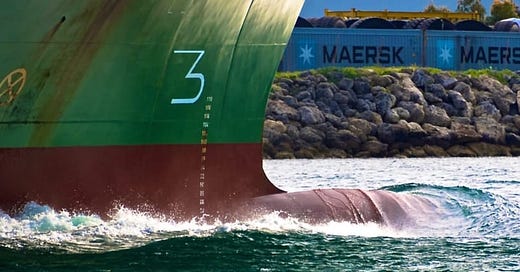multi-storied #14: Outtakes
Three stories from my reporting—not all of them strictly outtakes—and an invitation to a talk:
I spent some time last week talking over the phone to Indian seafarers: men and women who get contracted to sail on cargo ships. The second wave of the pandemic has made life miserable for many of them. Those who are on shore can’t get new contracts, because companies are reluctant to recruit people from India at the moment. One man came back from his last trip in April, and he probably won’t go back out to sea until September—if that. (When his ship was waiting to be piloted into the Houston port in late February or early March, incidentally, he spotted a ship ahead and tried to raise its crew on the radio, to see if he had any friends on board. He didn’t. Three weeks later, he found the ship’s name all over the news. It was the Ever Given.)
Another seafarer, a second engineer, told me that his last contract, which was supposed to last five months, stretched out to eight; the man who was supposed to replace him in Singapore caught Covid. In those eight months, he said, he didn’t step on dry land once, because port authorities are inflexible about shore leave during a pandemic.
One practical reason to disembark in a port is to watch the draft marks (shown in the photo above) as a ship is loaded. The more cargo a ship takes on, the lower it sits in the water. Even this wasn’t permitted, the second engineer said. So the crew hung a net from one of the deck cranes, and a man climbed into the net. Then the boom swung out over the side of the ship and lowered the net until the man could read the draft marks accurately.
Short notice, but: on Thursday, July 17, I’ll be speaking to Larissa MacFarquhar about her book “Strangers Drowning,” which is a fascinating collection of analyses and case studies in radical idealism. Families adopt children until they can afford no more; ordinary people give away most of their income, or they devote their lives to helping strangers. The book is written in Larissa’s unique, intimate, careful voice. (I can do no better than point you to her profile of Hilary Mantel.) Details of Larissa’s talk below. It’s open to everyone!


How carefully we imagine policymakers must be in setting economic policy. In most developed countries, for instance, central banks are strident in their singular ambition to control inflation—to keep it hovering in the neighbourhood of 2%. That 2% figure is, at least in the OECD countries, remarkably uniform and remarkably rigid. In the UK, for instance, if the rate rises to 3% or falls below 1%, the governor of the Bank of England has to write a letter to the Chancellor of the Exchequer to explain what in heaven’s name going on.
How was this 2% number picked? In short: on a whim.
The first country to follow this target was New Zealand. In the 1988, when the country was trying to rejig its monetary policy and rein in inflation, the finance minister was asked on TV what rate he’d be happy with. Between 0 and 1%, the minister said on air. After some additional government confabulations, the range expanded to 2%. Much later, Don Brash, New Zealand’s central banker, said: “It was almost a chance remark. The figure was plucked out of the air to influence the public’s expectations.”
And that was that. Central banking is such a closed priesthood that others soon adopted the number, to the point that it became hallowed orthodoxy—the foundation on which monetary policy continues to be made until this day.
I’m running a third edition of my Guardian Masterclass on writing LongReads, of the kind you’d see in the Guardian Long Read or the New Yorker. If you’re keen on knowing what goes into the making of these sausages, sign up here—and tell your friends! Seats usually go quite quickly, but this Masterclass is online, so we have an expanded classroom—which, additionally, makes it easy for people to tune in from anywhere in the world.
I was talking yesterday to a man from New Zealand, a guy who’d grown up on a dairy farm. The farm is still around, and he was telling me how much things have changed.
When he was a boy, milking machines were already around. It took two or three people to work the machines, though. You’d have to lead the cows to the room with the machine, and then get them set up on the platform, and affix the milking cups to them. After they were done, the cows had to be led off the platform and back out to their particular pasture lots.
Now, though, the post-milking stage of the process is automated. Cows wear collars—often made by a New Zealand company called Halter—which use soft sounds and vibrations to guide the animals one way or another. The cow comes off the 60-cow rotary milking platform and is nudged out of the door, to the right or the left, down this path or that, all the way back to its rightful pasture.
“And fence breaks!” my guy said. On a large farm, farmers frequently install fence breaks, to delineate one pasture from the next. Now they can install virtual fence breaks—imaginary boundaries fed into the software, so that if a cow comes up against them, they’re gently steered back. “On the app, farmers can look at their farms, and they can see where the cows are, and they can move their virtual fence breaks up further or remove them, to allow the cows to graze more extensively,” he said. “The ads for these devices usually show the farmer lounging on the deck of his fishing boat, doing his farming on his phone.”




